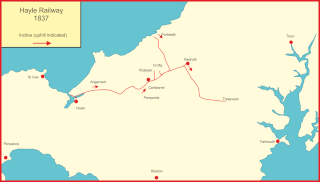
The A30 is a major road in England, running 284 miles (457 km) WSW from London to Land's End.

The River Camel is a river in Cornwall, England. It rises on the edge of Bodmin Moor and with its tributaries its catchment area covers much of North Cornwall. The river flows into the eastern Celtic Sea between Stepper Point and Pentire Point having covered about 30 miles, making it the second longest river wholly in Cornwall. The river is tidal upstream to Egloshayle and is popular for sailing, birdwatching and fishing. The name Camel comes from the Cornish language for 'the crooked one', a reference to its winding course. Historically the river was divided into three named stretches. Heyl was the name for the estuary up to Egloshayle, the River Allen was the stretch between Egloshayle and Trecarne, whilst the Camel was reserved for the stretch of river between its source and Trecarne.

St Erth is a civil parish and village in Cornwall, England.

The Hayle Estuary and Carrack Gladden SSSI is a Site of Special Scientific Interest, noted for its biological interest, in west Cornwall, England, UK. It consists of three distinct parts, each of which is covered in a separate article: the Hayle Estuary, the sand-dune system of Porth Kidney Sands and the coastal headland at Carrack Gladden.

Hayle is a port town and civil parish in west Cornwall, England. It is situated at the mouth of the Hayle River and is approximately seven miles (11 km) northeast of Penzance.

Hayle railway station serves the small town of Hayle, Cornwall, United Kingdom. Great Western Railway manage the station and operate most train services.

Angarrack is a village in west Cornwall, England, UK. It is in the parish of Gwinear-Gwithian a mile to the east of Hayle. Immediately south of the village Angarrack viaduct carries the Cornish mainline railway over the Angarrack River. The name comes from An Garrek which means "The Rock" in the Cornish language. According to the Ordnance Survey the spelling is Angarrack but on signs near the village, it is variously spelled Angarrack, Angharrack, or Angarrick.

Portreath is a civil parish, village and fishing port on the north coast of Cornwall, England, United Kingdom. The village is about three miles (5 km) northwest of Redruth. The village extends along both sides of a stream valley and is centred on the harbour and beach. West of the harbour entrance and breakwater are two sandy beaches that are popular with holidaymakers, surfers and naturists.
The West Cornwall Railway was a railway company in Cornwall, Great Britain, formed in 1846 to construct a railway between Penzance and Truro. It purchased the existing Hayle Railway, and improved its main line, and built new sections between Penzance and Hayle, and between Redruth and Truro, and opened throughout in 1852.

The Cornwall and West Devon Mining Landscape is a World Heritage Site which includes select mining landscapes in Cornwall and West Devon in the south west of England. The site was added to the World Heritage List during the 30th Session of the UNESCO World Heritage Committee in Vilnius, July 2006. Following plans in 2011 to restart mining at South Crofty, and to build a supermarket at Hayle Harbour, the World Heritage Committee drafted a decision in 2014 to put the site on the List of World Heritage in Danger, but this was rejected at the 38th Committee Session at Doha, Qatar, in favour of a follow-up Reactive Monitoring Mission.

The Hayle Railway was an early railway in West Cornwall, constructed to convey copper and tin ore from the Redruth and Camborne areas to sea ports at Hayle and Portreath. It was opened in 1837, and carried passengers on its main line from 1843.
The Port of Hayle is an important mining port, harbour and former industrial centre located in the town of Hayle, on the north coast of Cornwall. The Port is within the area of the Cornwall and West Devon Mining Landscape World Heritage site.

John Harvey was a Cornishman whose career started as a blacksmith and engineer at Carnhell Green near Hayle, in west Cornwall. In 1779 he established a foundry and engineering works at Hayle called Harvey & Co. By 1800 the company employed more than 50 people and continued to grow as Harvey worked with many of the great Cornish engineers and entrepreneurs of the day. These included Richard Trevithick, William West, and, more importantly, Arthur Woolf. In 1797, Harvey's daughter, Jane, married Richard Trevithick.

Restronguet Creek is a tidal ria in south Cornwall, United Kingdom. It is a tributary of Carrick Roads, the estuary of the River Fal, and is situated approximately four miles (6.5 km) south of Truro and three miles (5 km) north of Falmouth.

Chycoose, Point and Penpol form a coastal settlement around Penpol Creek in Cornwall, England, United Kingdom.

Copperhouse is an eastern suburb of Hayle in west Cornwall, England. It grew up around the Copperhouse Foundry, which was run by Sandys, Carne and Vivian.

The A3071 is a minor 'A' road in the English county of Cornwall, which links St Just to Penzance and the A30. It is 6.2 miles long.
The Cornish Copper Company (CCCo) was originally a copper smelting business founded in Camborne, Cornwall in 1756. However it soon moved to Hayle and by 1758 had constructed its copper smelting works there. By 1769 the company had built the grade II listed Copperhouse Dock.



















